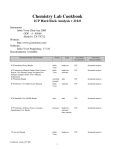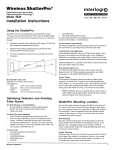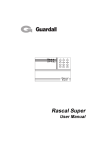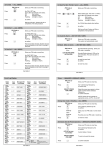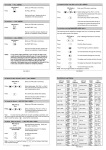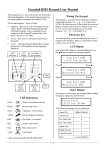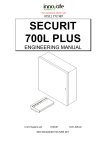Download Rascal Plus Installation Manual
Transcript
1 2 3 4 5 6 7 8 9 * 0 # ⊕ ⊕ Rascal + Rascal + Installation Instructions RASCAL + INSTALLATION INSTRUCTIONS Introduction The Rascal+ is a keypad operated microprocessor alarm control unit. It has a host of enhanced features not normally found on a control panel of this size. It is provided with a dedicated final Entry/Exit, Intermediate entry circuit, and two alarm zones. A common 24hr. circuit and a separate Personal Attack circuit are also provided. Mechanical It is housed in an attractive, durable 3mm thick polycarbonate box. To gain access to the printed circuit board, remove the lid fixing screws. Cable entry points and routing channels are provided on each side of the box. Fixing A top keyhole fixing is provided. Fix top securing screw, hook onto the top keyhole and mark the position of the other holes. Remove the unit. Drill and plug the remaining fixings then secure to the wall. Mains Wiring CAUTION......... THE ELECTRICAL INSTALLATION SHOULD COMPLY WITH THE LATEST I.E.E. WIRING REGULATIONS. IF IN DOUBT CONSULT A QUALIFIED ELECTRICIAN. The supply should be taken from an unswitched fused spur outlet. A three-way mains terminal block is fitted below the printed circuit board. Other Wiring All other wiring should use British Standard security cable to the other terminals as listed in the connection chart. The routing of these cables should be kept away from sources of possible interference. i.e. fluorescent lights, central heating thermostats and fuse boxes etc. First Powering Up When power is first applied the alarm will come on in a tamper condition. Enter the factory default code (1-2-3-4) to stop the sounder then press the # to reset to normal. Display Interpretation The first zone to alarm will indicate with a continually lit LED. Any secondary or subsequent alarm zones will be indicated by a fast flashing LED. Any isolated zones will be indicated by a slow flashing LED. Operation Notes There are three 'set' positions. Full set arms all zones. Two part sets are provided both isolate Zone 2 and make the IX circuit into a second delayed entry circuit. Part set (* and 0) allows the external bell to ring. Home set (* and 4) disables the external bell and strobe. 1. Full Set Enter the user code (default 1-2-3-4). The sounder will emit a steady tone and the exit timer will start. Leave the protected area by the appropriate route. 2. Part Set Enter the user code then press the * and 0 keys. The sounder will emit a steady low tone and the exit timer will start. Zone 2 will be isolated and it's LED will pulse. The IX circuit will become a second delayed entry circuit. Leave the protected area by the appropriate route. With part set the external bell will sound in the event of an alarm. 3. Home Set Enter the user code then press the * and 4 keys. The sounder will emit a steady low tone and the exit timer will start. Zone 2 will be isolated and it's LED will pulse. The IX circuit will become a second delayed entry circuit. Leave the protected area by the appropriate route. With home set the external bell and strobe are disabled. 4. Setting with Individual Circuits isolated. Enter the user code. The sounder will emit a steady tone. Press the * key and the number key for the zone to be isolated. The LED for that zone will pulse. The IX zone (intermediate entry) is isolated by key number 3. If more than one zone is to be isolated then each zone number must be preceeded by the * key i.e to isolate zones 1 and 2 enter code followed by *1 then *2. 5. Any Exit Faults This will cause the exit timer to halt and the sounder to pulse. The circuit LED will light. When the fault is cleared the LED will go out and the exit timer will restart. The alarm may not be 'set' with a fault present. The minimum exit time folllowing an exit fault will be 5 seconds. 6. 24hr Tamper When the panel is set a tamper alarm will activate the internal and external sounders and the strobe. When the panel is not set (during the day) a tamper alarm will activate the internal sounder only. In both cases the tamper LED on the control panel will be lit when unset. Reset the panel and clear the fault. 7. Personal Attack In alarm both the internal and external sounders, and strobe will operate. The PA LED on the control panel will be lit. Reset the alarm and reset the PA button. 8. Stopping the Bells Following an alarm enter the user code to stop the bells or sounders. 9. Entry Upon entry if all is clear the sounder will emit a steady tone. In the event of there having been an alarm condition which has auto reset the sounder will pulse. In the last remaining 15 seconds of the entry time the sounder will emit a rapid pipping 'entry hurry' up tone, go directly to the alarm and enter the user code. 10. Resetting To reset following any alarm condition, enter the user code. The sounder will emit a 'bip-bop' reset required sound. Press the # key to reset. If either the tamper or PA circuits are in fault the LED's for those zones will flash. Reset the PA push or clear the tamper fault. 11. Bell Test Key In User Code Key Numbers *9 Conditions All the LEDs will light There will be a 10 second pause then :The internal sounder will operate for 5 seconds. The external bell will operate for 5 seconds. The strobe (where fitted) will operate for 5 seconds. The control will then automatically revert back to day mode. 12. Security Code Programming The control unit has a 4 digit security code that is programmable only by first entering the original code. Key In Key Numbers User code *91 Note : The factory default code is (1-2-3-4) Enter New user code 13. Reading Logs The Rascal+ includes a logging mode which allows a recall of the last two set and unset events. Key In User code Key Numbers *93 Conditions A steady tone and the display indicating the last set state. TO VIEW ANY DAY'S LOG Key View 1 Log 1 'SET' 2 Log 2 'SET' Key # # View Log 1 'UNSET' Log 2 'UNSET' The log is organised as 'SET' and 'UNSET' events. All events are recorded. The first to alarm is shown by the relevant LED being lit continuously. Subsequent alarms as shown by a fast pulse of the relevant LED. Any zones isolated are shown by a slow pulse on the relevant LED. When this option is first entered the display will be showing log 1 'SET' state. To display the 'UNSET' (Day) conditions press the # key. The buzzer will sound whilst viewing the 'SET' logs. Any key press error will cause a return to viewing Log 1 'SET'. To revert back to day mode press the * key. 14. Walk Test Key In User code Key Numbers *94 Conditions A steady tone The zone alarm devices may now be operated. The display will show the zones operated and a high level sounder will follow the status of the zone under test. To revert back to day mode press the * key. Note : PA or tamper circuits may not be walk tested. An alarm condition will be generated upon operation. 15. Chime Control The chime is a tone associated with the entry/exit zone (FX) and can be used to alert the user to any intrusion during the unset times. The chime can be turned on and off while the alarm is not set as follows : To enable, press * followed by the 4 key. The FX LED will light. Press the * key to revert back to day mode. To disable, press * followed by the 4 key. The FX LED will go out. Press the * key to revert to day mode. To check the Chime simply press the * key. If the FX LED lights the chime function is on. If the LED is off then the chime function is off. Always press the * key to revert to day mode when finished. If the * key is not pressed after 15 seconds have expired, the control panel will revert to day mode automatically. CONTROL OUTPUTS 1. ID - Output This is a supply negative (0V) feed for Viper detectors, shatterbox and smoke detectors which require a temporary removal of power to clear their alarm memories. The terminal pulses off when the alarm is turned to 'Set' (1/2 second pulse) or at 'Reset' (3 second pulse). Current limit 50 mA. 2. L+ Latch Line (Set/Unset) This output is for controlling latching PIR detectors. The line goes to 12V when 'set' and returns to 0V when unsetting occurs. 3. 12V Auxiliary This is the supply for PIR or other powered detectors. The maximum permissible load is 150 mA 4. Battery Fuse The battery fuse is a 20mm 1 Amp anti surge type. Connections Terminal Group 1. Alarm connections No Name Description 1&2 24 Tamper Common tamper loop 3&4 PA Personal attack circuit 5&6 1 Alarm Zone 1 7&8 2 Alarm Zone 2 9 & 10 IX Intermediate entry circuit 11 & 12 FX Entry/Exit circuit Terminal Group 2 No 13 14 15 16 17 Name EXT+ SPKIDL+ ST- 18 19 SH- 20 21 22 23 24 + C D AUX + AUX - Power and Control Description Extension speaker connections Fit a maximum of 2 extra 16 Ohm speakers Switched negative voltage feed Set line for latching detector (each to alarm) Strobe switched negative. Fit a maximum of two low current strobes. Bell signal negative Self actuating siren hold of negative. This terminal goes open circuit in alarm. Bell relay contacts rated at 1A max. Bell hold off positive supply Remote keypad clock signal Remote keypad data signal Auxiliary nominal 12V positive Auxiliary nominal 12V negative. Maximum current load 150 mA. OPTIONS 1. Quick Set Cut link A for quick set in part guard. The exit time will be 5 seconds. 2. Buzzer Volume Cut link B to reduce the buzzer ( low level sounder) volume. Sounders and Strobe Bell cut off is permanently selected. The internal sounder and strobe operation are modified when the bell ring time is set to 10 mins or less. Note : Fit a maximum of two low current strobes. Fit a maximum of two 16 Ohm extension speakers (in parallel). Bell Time Set 10 Mins or Less If a zone is in fault for 10 mins, that zone will be isolated permanently. If a zone is in alarm for shorter than the bell time the internal sounder and strobe will cut off with the bells at the end of the preset bell time. If a zone is in alarm for longer than the bell time the bell will stop at the end of the bell time and the internal sounder will stop when the zone resets or at 10 mins if the zone remains in fault. Bell Time Set 11 Mins or Longer If a zone is in alarm for less than 10 mins when the bell timer has finished the bell and the internal sounder will stop. The strobe will continue until the control panel is switched off. Timing Controls EXIT TIME ENTRY TIME BELL RING TIME 10 secs to 120 secs approximately 10 secs to 120 secs approximately 1 min to 40 mins approximately With all controls to increase the time, turn clockwise Timing Adjustments Exit, entry and bell controls are scanned at 5 min. intervals. When altering the times make the adjustment and enter the user code. Wait 5 seconds then press the # key. At this point wait a further 20 seconds for the controls to be scanned. The new settings will then be effective. Standard SAB Terminations Name Number 24 Tamper Bell + Bell S24 Tamper 1 20 18 2 Universal SAB 1 Terminations Name Number + SR - 12V Hold Off +12V Hold Off Bell + Bell Ring Negative Bell STamper Return Negative 24 Tamper 20 18 2 24 Tamper 1 + SR S+ F Universal SAB 2 Terminations Name Number 24 Tamper Bell + Bell S24 Tamper 1 20 18 2 24 Tamper ST - 2 18 20 1 17 Flashguard Terminations Name Number + SR S+ F - 12V Hold Off ST +12V Hold Off Bell + Bell Ring Negative 24 Tamper Tamper Return Negative Bell Ring Positive Bell S Tamper Feed 24 Tamper CQR Soundpac Terminations Number Name 24 Tamper Bell S Bell + - 12V Hold Off +12V Hold Off Bell Ring Negative Tamper Return Bell Ring Positive Tamper Feed 1 2 3 4 5 6 + Tamper Return - Tamper Return -ve Trigger + 12V Hold Off +12V Hold Off + LED Feed 7 8 9 10 11 No Connection NI - CAD Charge NI - CAD Battery 0V Ground -ve Strobe Trigger 17 20 1 18 2 Terminations Number Name 24 Tamper Bell S Bell + 2 18 20 + A D B F Strobe - 12V Negative Hold Off +12V Positive Hold Off Bell Ring Negative Tamper Return CQR Integra A/T Ret Siren Trig Supply + Select A/T - Fit Link Select A/T c Fit Enable Battery Link 24 Tamper ST - 1 17 Supply STR - Notes: 1. 2. 3. When connecting an SAB unit the lid tamper will cause the bell to ring from the SAB battery. Terminal 1 should always be used as the start of the tamper loop or the negative hold off feed for SAB unit. The tamper return from the Sab unit should be wired in series with all other tamper connections and connected into terminal 2. 1 MIN RV3 ENTRY BELL RV2 MAINS FX IX 24 PA 1 TAMPER LOOP TAMPER 2 IX FX 1 PA 2 IC2 BELL STROBE EXTENSION SPEAKER BELL TAMPER PRESSURE MAT BOX SPEAKER LID TAMPER Cut for PG QS OPTION 1 TAMPER ⊕ ⊕ ⊕ ⊕ ⊕ ⊕ ⊕ ⊕ ⊕ ⊕ ⊕ ⊕ 12 EXIT RV1 ULN2003 MIN OPTION 2 Cut for low volume BOX SPK + L S T IC3 S H RLY1 KEYPAD CONNECTOR + BATT 1A + AUX + - BATT a.c. + EXT SPK BELL C D ⊕ ⊕ ⊕ ⊕ ⊕ ⊕ ⊕ ⊕- ⊕ ⊕ ⊕ ⊕ ⊕ 24 13 I D BATTERY FUSE 47R 270R 2K2 TIMING CONTROLS 393 Part No 320232-04 MIN 7812 Guardall Limited Lochend Industrial Estate Newbridge Edinburgh EH28 8PL Tele: 031 333 2900 + TAMPER DATA CLOCK - 12V SUPPLY + } KEYPAD CONNECTIONS TRANSFORMER CONNECTOR








